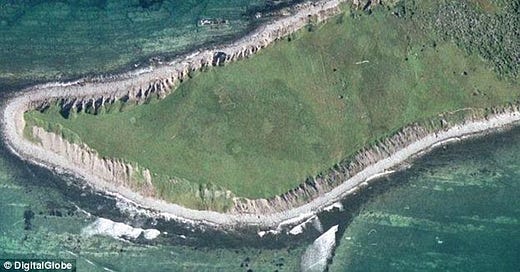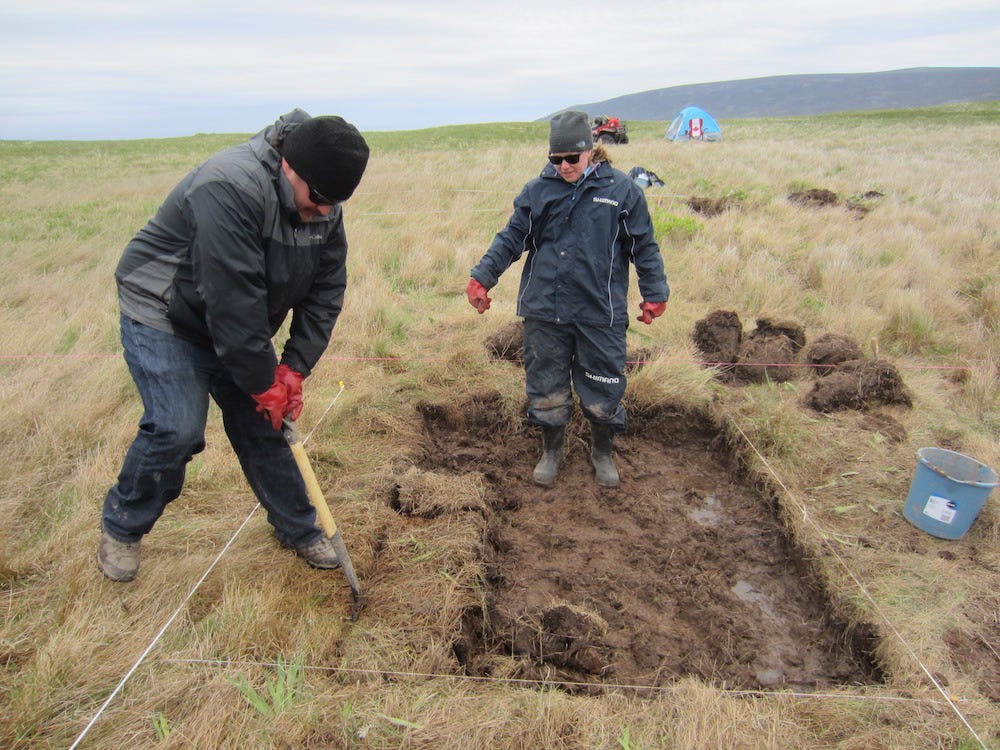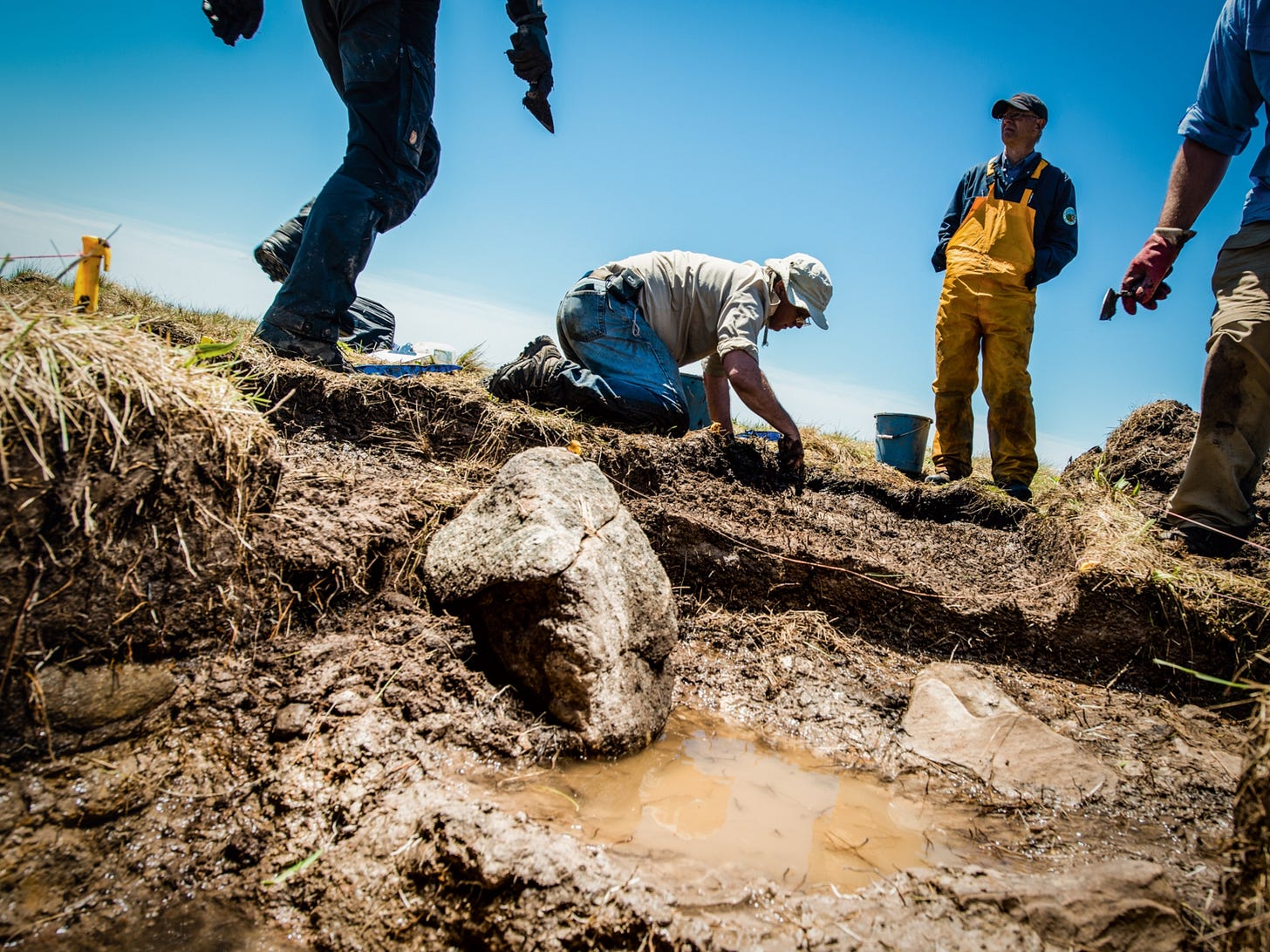The Point Rosee "Viking Site"
In 2014, high above the rugged coast of Newfoundland, something curious caught the eye of Dr. Sarah Parcak, a self-titled “space archaeologist.” From her vantage point in the stars, satellite imagery revealed a seemingly innocuous patch of land on the Point Rosee shoreline. But it wasn’t the ordinary wilderness you’d expect to find in this part of Canada. No, this was something different. This was a clue—an unmistakable rectangular shape buried under the earth, precisely the right dimensions for what might just be a Viking longhouse.
A rectangular shape at Point Rosee. A site so remote, so concealed, that even the most seasoned explorers had overlooked it. Could it be? Was this the discovery of a second Viking settlement in North America? A second chapter of the Norse story waiting to be uncovered? The world watched, breathless, as the possibility of rewriting history hung in the balance.
The Satellite Spark: A Tantalizing Glimpse
It all started with a simple satellite image. Dr. Parcak’s team, armed with the power of near-infrared technology, pored over the landscape of Newfoundland. They were looking for something specific—an anomaly, a telltale sign of something that didn’t belong in the natural surroundings. And there it was, hiding just beneath the surface: a rectangular feature. The dimensions were almost too perfect, too aligned with what you’d expect from a Viking settlement.
In the world of archaeology, this wasn’t just a find. It was a bombshell. L'Anse aux Meadows had long been the single known Viking site in North America. But Point Rosee? If it was what Dr. Parcak’s team thought it was, this discovery could change everything. Could this be the lost Viking outpost in Newfoundland? Had the Norse traveled further along the coastline than we ever imagined?
The Excavation: The Shovels Are Ready, But So Are the Skeptics
The team arrived in 2015, with anticipation that felt almost tangible. The excitement in the air was thick, heavy with the weight of the discovery they thought was just waiting to be uncovered. Shovels were raised, the earth was pierced, and the site was slowly—carefully—exposed. What would they find? Could they unearth remnants of Viking life?
At first, it seemed promising. A stone-lined feature that could have been a structure. Iron-rich deposits that hinted at metalworking. And a cracked boulder, possibly the remnants of a Viking hearth, worn by time and the elements, waiting to tell its story.
It seemed almost too perfect. Could this be it—the breakthrough moment that would put Point Rosee on the map as the second Viking site in North America?
But the deeper the team dug, the more the pieces of the puzzle began to fall apart.
The Unraveling: No Vikings, Just Natural Forces
By the time 2016 rolled around, it was clear that Point Rosee wasn’t the Viking treasure trove they had hoped for. What they thought were signs of Viking ironworking? Simply bog iron—nothing more, nothing less. The stone-lined feature? Nothing more than a natural rock formation, shaped over time by the relentless forces of nature. The cracked boulder that had once seemed like a hearth? Just another casualty of the weathering process.
The artifacts that had been anticipated with bated breath? There were none. No tools, no weapons, no evidence of Viking occupation. It was as if the land itself had played a cruel trick on their hopes and dreams. No longhouses. No Vikings.
The satellite images that had sparked the frenzy? They were just an illusion. A mirage. The rectangular feature was nothing more than a quirk of nature, cleverly disguised as something man-made.
But what about the initial excitement? What about the satellite’s promise of a buried Viking past? Had it all been for nothing?
Theories and Speculations: What If?
Yet, the mystery of Point Rosee refuses to be laid to rest. While the official narrative states that the site was not a Viking settlement, there are still whispers—questions that hang in the air like the fog over Newfoundland. What if the site was a temporary Viking outpost, just a fleeting trace of their journey across the North American coast? Maybe they didn’t leave behind artifacts or structures because they never stayed long enough to do so.
One theory suggests that Point Rosee could have been a stopover for Norse explorers who were processing bog iron—a resource they used for forging tools and weapons. The presence of iron-rich deposits could be evidence of this, though there’s no tangible Viking evidence to support it. Could it be that the Vikings stopped at Point Rosee for a brief moment, gathering what they needed before moving on? Could they have left behind nothing more than traces of their brief presence?
Others still speculate that the site may have been misinterpreted from the beginning. Maybe it was never meant to be Viking. The patterns in the satellite imagery could have been nothing more than natural formations, an accident of geography that tricked the eyes of the archaeologists into believing something that wasn’t there.
The Legacy: The Unanswered Questions
As the dust settles and the excavation reports are filed away, one thing remains undeniable: Point Rosee will forever be a question mark in the history of Viking exploration. It wasn’t the second L'Anse aux Meadows that many hoped for, but in the end, its failure to provide concrete evidence might only fuel the myth. After all, what’s a legend without a bit of uncertainty?
Sources:
Smithsonian Magazine - "Archaeologists Spy New Viking Settlement From Space"
The Canadian Press - "Viking Settlement Found in Newfoundland"
Read more hereNational Geographic - "The Vikings Were Here—But Was It Really?"
Read more hereBBC News - "Viking Site in Canada Unlikely, Say Experts"
Read more hereThe Globe and Mail - "Point Rosee and the Viking Controversy"
Read more hereLive Science - "Point Rosee Viking Site: Satellite Discovery and Excavations"
Read more hereNewfoundland and Labrador Heritage - "Point Rosee Excavations and Findings"
Read more hereThe Star - "Newfoundland Viking Site Excavation Yields Little Evidence"
Read more here







